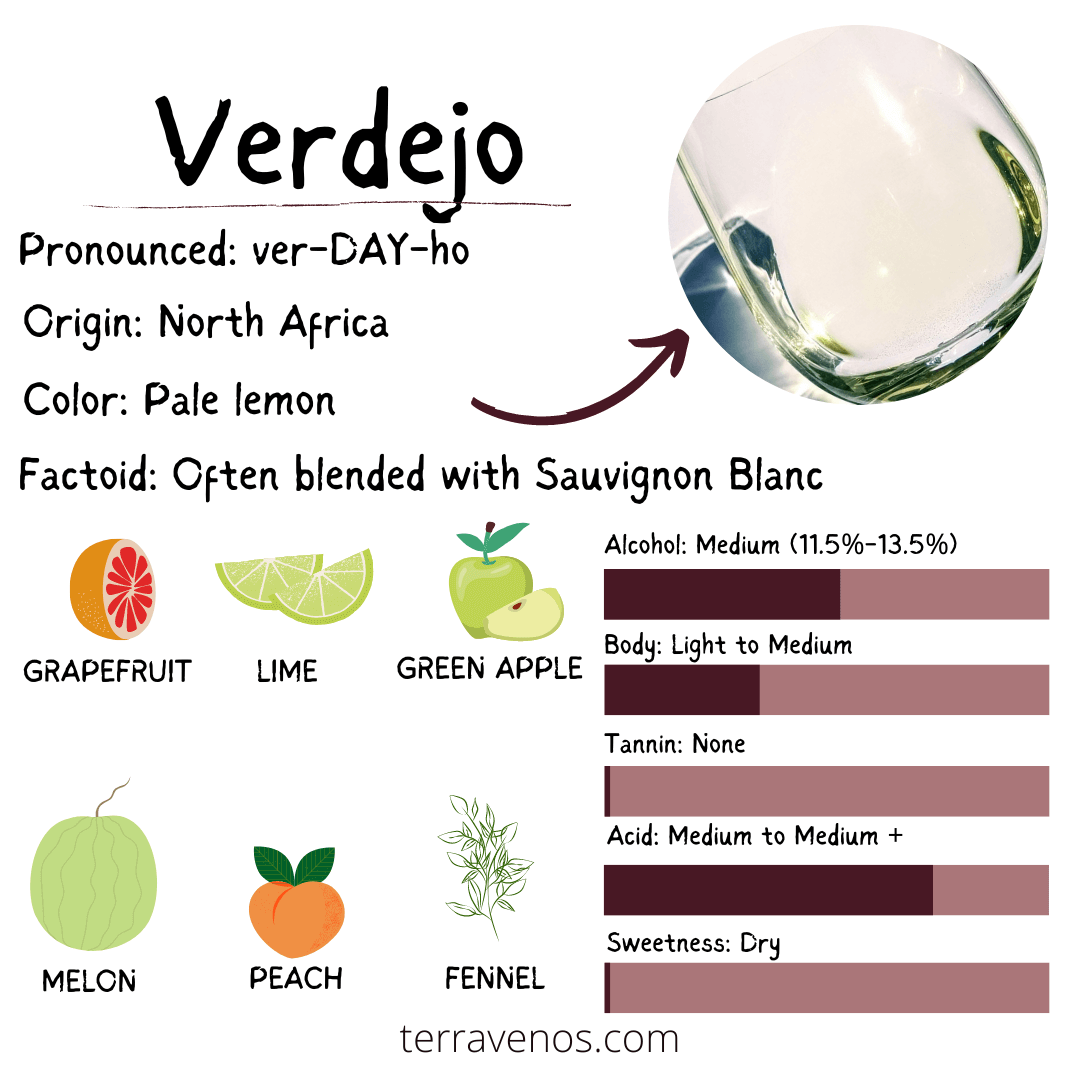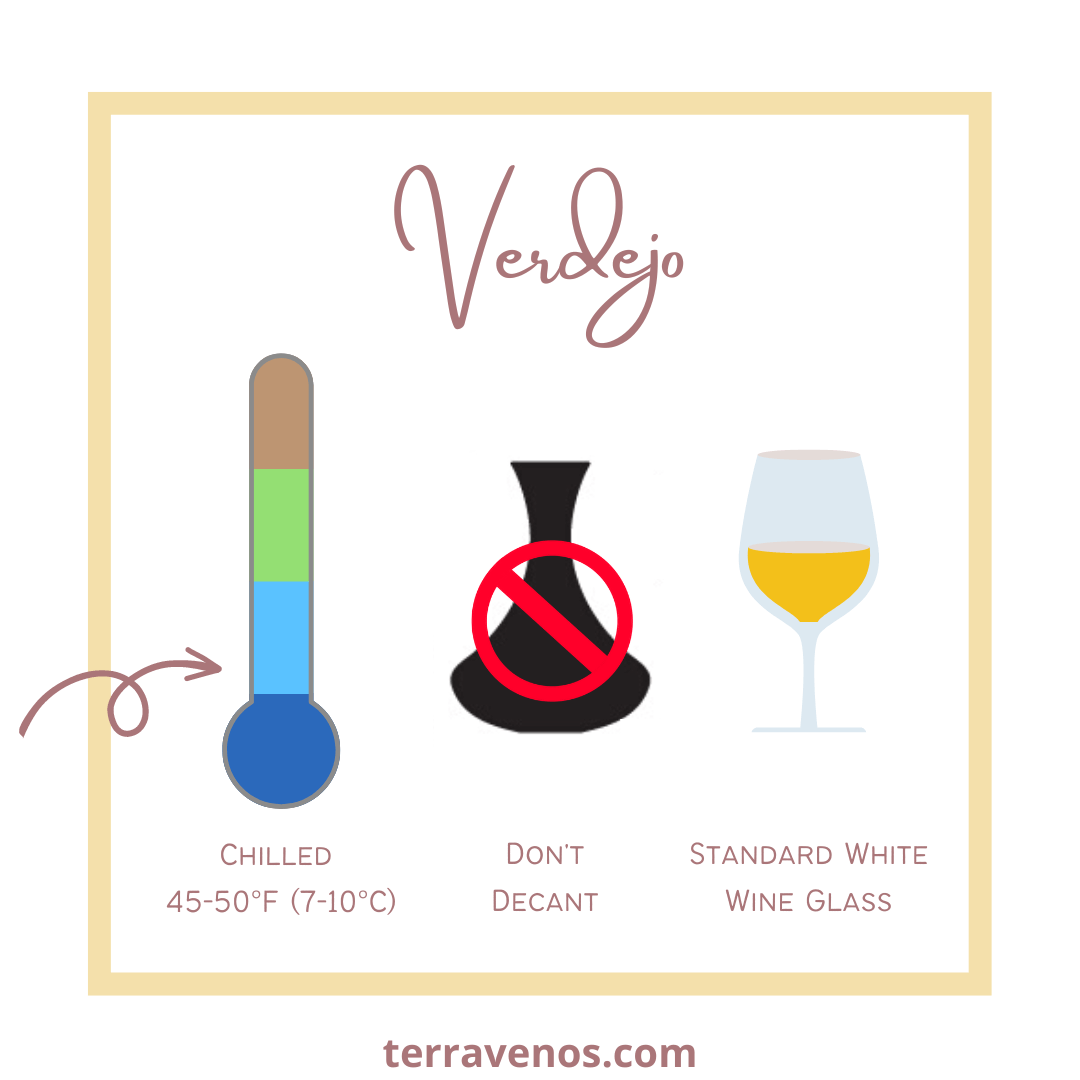
Pronunciation: ver-DAY-ho
Verdejo, a white wine varietal, finds itself at home in Spain’s Rueda region. If you’re just getting into white Spanish wines, then Verdejo needs to be on your bottle list.
TL;DR: If you like Sauvignon Blanc, you’ll probably enjoy Spain’s Verdejo wines.
- What Kind of Wine is Verdejo?
- Where Does Verdejo Wine Come From?
- What Does Verdejo Smell Like?
- What Does Verdejo Taste Like?
- Food Pairing Suggestions for Verdejo
- Verdejo vs. Other Varietals
- How to Serve Verdejo Wine
- Verdejo Synonyms
- Notable Verdejo Producers and Bottles to Try
- Emerging Trends and Innovations
- Final Thoughts – Verdejo as a Must-Try White Wine Varietal
What Kind of Wine is Verdejo?
Verdejo is a medium-bodied white wine with crisp acidity, offering a refreshing and vibrant character. It showcases a range of flavors and styles, including citrus, green tree fruit, and light herbal notes, making it a versatile choice for wine lovers.
Where Does Verdejo Wine Come From?
Verdejo, a grape variety originating from North Africa, traveled across to the Iberian Peninsula probably by the Mozarabs. It found its way to the Rueda region in Spain in the 11th century, where it made an oxidized, Sherry-esque style of white wine.
Remarkably, Verdejo almost went extinct in the mid-1900s.
A dedicated grower, Angel Rodriguez Vidal, dedicated his work to re-establishing Verdejo. Luck for us!
Helpful Tip: Here’s a post that goes more into the history of Verdejo wines. Check it out if you’re curious.
The unique terroir and climate of Rueda provide an ideal environment for cultivating Verdejo, allowing it to flourish and exhibit its distinctive characteristics.
Styles of Verdejo
Verdejo wines come in different styles, ranging from young and zesty to aged and complex. Fresh and youthful Verdejo wines are known for their vibrant citrus and tropical fruit flavors, while oak-aged examples develop richer textures and layers of complexity with notes of vanilla and spice.
Verdejo in Rueda
The Rueda region, renowned for its dedication to Verdejo production, is the heartland of this varietal. Here, Verdejo vines thrive in the region’s sandy soils and benefit from the continental climate, resulting in wines that showcase the true essence of Verdejo. Rueda Verdejo wines are known for their lively acidity, expressive aromatics, and crisp, refreshing profiles.
Helpful Wine Buying Tip: If you see Rueda DO (Denominación de Origen) on a white wine label, it has a minimum of 50% Verdejo.
Other Notable Verdejo Growing Regions
Outside of Rueda, Verdejo has gained recognition in other wine regions. In regions such as Tierra de Castilla and Valdepeñas, Verdejo is grown to produce refreshing and fruit-forward expressions. Winemakers in these areas are exploring the potential of Verdejo and crafting wines that captivate with their distinct regional characteristics.
Fun Wine Fact: Verdejo isn’t the same grape as the Portugues Verdelho (which is confusing because they both make white wines – but Verdelho is also used in Madeira – see more here).
What Does Verdejo Smell Like?

Verdejo exhibits a distinctive aromatic profile with notes of citrus fruits such as lemon, grapefruit, and lime. It also offers enticing floral aromas, with hints of white flowers and herbs. In some expressions, Verdejo showcases a touch of minerality, adding complexity to its fragrance.
Fun Wine Fact: Did you know that Verdejo is often compared to Sauvignon Blanc for its vibrant aromatics and zesty character? See – that’s why if you like Sav Blanc, you should be drinking Verdejo!
What Does Verdejo Taste Like?
Verdejo displays a refreshing and lively taste profile. It delights the palate with crisp acidity, offering a vibrant and energetic sensation. Flavors of citrus fruits, including lemon and grapefruit, take center stage, accompanied by hints of green apple and tropical fruits. Verdejo’s characteristic herbal notes add further complexity and contribute to its distinct flavor profile.
Fun Wine Fact: Verdejo grapes are often harvested at night to minimize oxidation which helps keep the wine fresh and fruity.
Verdejo wines are known for their versatility, making them a perfect match for a wide range of dishes. From seafood to salads and even spicy cuisine, Verdejo’s bright acidity and fruity flavors complement various culinary creations.
Food Pairing Suggestions for Verdejo

Here are a few food pairing suggestions to enhance your Verdejo experience:
- Grilled shrimp or scallops with a squeeze of lemon
- Fresh goat cheese with a drizzle of honey
- Summer salads with citrus vinaigrette
Helpful Tip: Go check out this post that covers all of the different pairing recommendations for Verdejo wine. Yum!
Verdejo vs. Other Varietals
While Verdejo shares similarities with other white varietals, it boasts its own distinct character. Compared to Sauvignon Blanc, Verdejo offers a fuller body and a rounder mouthfeel. It combines vibrant fruit flavors with a refreshing acidity and a subtle herbaceous touch, setting it apart from other white wines.
Verdejo vs Sauvignon Blanc
| Category | Verdejo | Sauvignon Blanc |
|---|---|---|
| Acidity | Crisp acidity | Higher acidity |
| Body | Medium to full body | Light to medium body |
| Flavors | Citrus, tropical fruit, herbal | Crisp, citrus, green apple |
| Oak Aging | Some examples may have oak influences | Rarely aged in oak, emphasis on fruit freshness |
| Mouthfeel | Round, smooth | Light, refreshing |
| Notable Regions | Rueda (Spain), other regions in Spain | Marlborough (New Zealand), Loire Valley (France), California (USA) |
| Food Pairing | Grilled seafood, poultry, creamy sauces | Light seafood, salads, vegetarian dishes |
When you’re drinking Verdejo, it’s hard to ignore its unique personality!
Discover More:
Pinot Grigio vs Albarino
Chenin Blanc vs. Sauvignon Blanc
Pinot Grigio vs Vermentino
How to Serve Verdejo Wine

Temperature
Serve Verdejo chilled, around 45-50°F (7-10°C). This temperature allows the vibrant aromas and refreshing acidity of Verdejo to shine while maintaining its crispness.
Glassware
Choose a white wine glass with a narrow rim and a moderately sized bowl. This type of glass directs the aromas towards your nose, allowing you to fully appreciate the aromatic profile of Verdejo.
Decanting
Most Verdejo wines don’t require decanting. However, if you have an aged Verdejo with more complex flavors, decanting for a short time can help the wine open up and reveal its full potential.
Aging Potential
Verdejo is primarily enjoyed in its youth when its flavors are at their freshest and most vibrant. However, certain styles of Verdejo can develop intriguing nuances with a few years of bottle aging, enhancing the wine’s complexity and depth. Let price point be your guide.
Verdejo Synonyms
Verdejo is known by various synonyms, including Godejo and Palido.
Notable Verdejo Producers and Bottles to Try
When exploring Verdejo, seek out producers who specialize in crafting exceptional Verdejo wines. Some notable wineries include:
- Bodegas Naia (Rueda, Spain)
- José Pariente (Rueda, Spain)
- Marqués de Riscal (Rueda, Spain)
These wineries offer a diverse range of Verdejo wines, each with its own unique style and expression.
Helpful Wine Buying Tip: You can find entry-level Verdejo wines around $10-$15 USD. This is a great price point to start exploring Verdjo wines.
Check out this lovely video on Bodegas Naia. It’s in Spanish but gives a beautiful overview of the vineyards in Rueda.

Emerging Trends and Innovations
The world of wine is ever-evolving, and Verdejo is not immune to innovation. Winemakers are experimenting with new techniques and styles, pushing the boundaries of traditional winemaking. From extended lees aging to natural fermentation to fermenting in oak barrels, these innovations are shaping the future of Verdejo and introducing exciting dimensions to its already captivating character.
Final Thoughts – Verdejo as a Must-Try White Wine Varietal
With its refreshing acidity, vibrant flavors, and versatility, Verdejo is a white wine varietal that deserves attention. Here are three key takeaways to remember:
- Distinctive Flavor Profile: Verdejo offers flavors of citrus fruits, crisp apple, and refreshing herbs. Its lively acidity provides a zesty and invigorating profile while its rounded mouthfeel adds depth to the wine.
- Food-Friendly: Verdejo is a versatile companion for a variety of dishes. Its bright acidity and vibrant flavors make it a great match for seafood, salads, grilled vegetables, and light appetizers. It can also handle spicier cuisine, thanks to its refreshing qualities.
- Regional Diversity and Expression: Verdejo showcases the diversity of its expression across different regions. From the vibrant and aromatic examples of Rueda to the fruit-forward styles of Tierra de Castilla and Valdepeñas, each region brings its own unique character to Verdejo wines.
Verdejo is a white wine varietal that shouldn’t be overlooked. Its vibrant flavors, refreshing acidity, and versatility make it a must-try for wine enthusiasts.
Thirsty for More?
Looking for more white wine recommendations? Check out these other notable Spanish white wines that are worth trying.
If you’re hosting a wine tasting, take a look at this list of food pairings specifically designed for white wines.



